Summary of Ivan Aivazovsky
Over half of Ivan Aivazovsky's approximately 6,000 paintings are maritime subjects and of these the most enduringly powerful are his turbulent seascapes that made him the success of the late Russian Empire. However, as momentum for change grew in late-nineteenth-century Russia, Aivazovsky's technical prowess and prolific output remained tied to his successful formula. His attachment to Romanticism remained especially apparent in his paintings of storm-tossed vessels dwarfed by natural grandeur, while his patriotic attachment to the Russia of old remained apparent in his paintings of naval victories. A younger generation of Russian artists, who engaged more creatively with a changing world, quickly eclipsed Aivazovsky in importance, but the market for his work remains buoyant to this day and his best seascapes still communicate a raw energy.
Accomplishments
- Aivazovsky was one of the last great academicians in the Russian art world, a product of the network of European academies, a Westernizer due to his travels around Europe's artistic capitals, a favorite of the Imperial family, but increasingly out of step with reformers calling for a more socially responsive and authentically Russian art.
- Aivazovsky can best be understood as the artistic boy from a poor background in a Black Sea port who found that well-connected patrons could transport him to the glittering world of St. Petersburg, from where he returned to his hometown a success and a celebrity. When the Black Sea erupts through the well-mannered surfaces of his paintings, as it occasionally does, the polite salons of St. Petersburg seem to give way to the Armenian boy's awe before elemental forces.
- An extraordinarily fast and prolific painter, often on a grand scale, Aivazovsky at his best injected the energy of late Romanticism into scenes that were otherwise coldly accomplished in their self-conscious grandeur and striving for pathos. Some of his late seascapes embody this energy in a less mannered way and the physical expressiveness of these painted surfaces still speaks to a more modern interest in the materiality of painting.
- A young Aivazovsky and the elderly English painter J.M.W. Turner met when they were both visiting Rome. They admired each other's work and both painted the sea with an expressive turbulence. However, a fellow member of the Royal Academy in London could still deride Turner's late paintings as "blots" whereas Aivazovsky's early work was garnering acclaim for its classical virtues.
Important Art by Ivan Aivazovsky

Chaos (The Creation)
Though mawkish to a contemporary eye, Chaos (The Creation), painted in his early twenties when Aivazovsky was living in Rome, following his studies at the Imperial Academy in St. Petersburg, was acquired by Pope Gregory XVI who had it hung in the Vatican, despite controversy around its literalistic depiction of a divine presence. In this regard, Nikolai Gogol, the Russian-Ukrainian writer and friend of Aivazovsky wrote: "Your Chaos caused a chaos in the Vatican."
The chaos to which the title refers is, of course, that from which the Christian God created the world, depicted here as an act of commanding the natural elements to take form and submit to the divine presence. Whether mischievously pandering to literal-minded taste or reflecting the painter's own genuine belief, the painting was something of a blockbuster hit for the ambitious young man doing his European tour and proved to Aivazovsky that the sublime sells in the right context.
The lower half of the painting shows early signs of Aivazovsky's extraordinary technical competence in painting stormy seas. In Chaos (The Creation), the upper half of the painting suggests a painter still trying to decide what to do with that competence, with his own God-like command of his materials, and whether his attachment to Romanticism required a glorification of something more than nature's own powers.
Oil on Canvas - Collection of San Lazzaro degli Armeni, Italy

The Ninth Wave
The Ninth Wave, usually cited as Aivazovsky's most famous work, is a huge painting of nearly eleven feet (three meters) by seven feet (two meters), which portrays a group of people clinging to flotsam from a wrecked ship, in the midst of a tempestuous sea surrounded by the brilliant gold tones of the sunrise. The title refers to a traditional nautical belief that the ninth wave is the last, largest, and most deadly wave in a series, at which point the cycle begins again. Painted when Aivazovsky was thirty-three years old, it is characteristic of his mature Romanticism in technique, theme and populist appeal.
The Christian message is less explicit, being confined to the cross-like form of the mast and the pleading attitude of the unfortunates clinging to it, as they look to the rising sun just before the big wave strikes. Displaying the classical academic discipline of composition and palette that Aivazovsky had been taught and then observed in the galleries and salons of the European capitals, The Ninth Wave has all the melodrama of Aivazovsky at his most febrile and all the grandeur of his most strident efforts to impress. The epic quality, which according to Russophile writer and poet Rosa Newmarch, in her perceptive early comments about his work, had become "increasingly pronounced" by this point, did not yet consistently offer the more "truthful vision" of which she found Aivazovsky to be capable.
Oil on Canvas - State Russian Museum, St. Petersburg

The Rainbow
English novelist Virginia Woolf referred to Dostoyevsky's novels as "seething whirlpools ... waterspouts which hiss and spout and suck us in". It is perhaps no coincidence then that Dostoyevsky loved this painting, seeing in it the thrill "that startles a spectator in a real-life storm." With this work, Dostoevsky claimed that Aivazovsky became a "master who has no competition." Woolf's contemporary, the writer Rosa Newmarch, traveled extensively in Russia, immersed herself in its art and culture, and wrote of Aivazovsky's "truthful vision" in paintings such as The Rainbow.
The painting portrays survivors tossed in a tempestuous sea, as their ship sinks in the background after a wild storm. The colors of the atmosphere and of the ocean are muted and use a soft subdued palette of white, pink, purple and light blue; shifting in subtle shades, they seem to morph and blend, creating a mood of windswept resignation in sharp contrast with the over-stated melodrama of The Ninth Wave from two decades earlier. An almost imperceptible rainbow tinges the clarity that seeps across the sky from the right.
There is a whirlpool effect to the painting as a whole, its swirl of spray, clouds, and sea insistently drawing the eye away from the softly defined periphery and into the space between men and ship, where it feels as if the storm may be starting to pass, sweeping away to the left of the scene. The thrill that Dostoyevsky detected was the thrill of the storm's power but also of how the faint emergence of the rainbow hints at its passing. The pathos of the ship's loss gives way in the instant to our recognition of the complex thrill that the sailors would be feeling. Such moments of startled feeling are perhaps what Newmarch meant by a "truthful vision" in Aivazovsky's best work.
Oil on Canvas - The Tretyakov Gallery, Moscow, Russia

The Black Sea
It is instructive to compare The Black Sea with the French tradition of seascape painting that Aivazovsky was linked to through Philippe Tanneur and which included paintings by Géricault such as The Storm (or The Shipwreck). Aivazovsky's technique was undoubtedly shaped early on by Tanneur's and the latter's Steamer Off Dover resembles The Black Sea in its foregrounding of rolling waves with spume-fringed crests. But Tanneur's water is always more like Géricault's, sculpted and frozen in time. As his own technique outstripped his early teacher's, Aivazovsky was able to capture a greater sense of motion, as if the French painters' attention to surface detail got in the way of their communicating fluidity and depth.
In The Black Sea that depth is unmediated by the presence of boats or human figures (the only vessel is on the horizon), and the painting's striking achievement is in refusing us the distance that those mediating presences usually afford. Instead, we are virtually in the water. It roils around us and the impression of motion is irresistible. The water has a labile density instead of a sculpted surface. Aivazovsky's characteristic lightness of touch in the sky makes it pellucid, which adds to the density and depth of the water, where Géricault's and Tanneur's skies always competed with their seas.
The Black Sea would be followed by Stormy Coastline in 1882, A Heavy Sea in 1889, and The Waves in 1898, a quartet of extraordinary paintings devoid of Aivazovsky's otherwise characteristic attachment to the pathos of the distressed at sea or the sublimity of light glowing through darkness. Those were tropes of his marketable output but he could go beyond them at times to produce paintings of enduring physicality and power like this one.
Oil on Canvas - The Tretyakov Gallery, Moscow

Descent of Noah from Ararat
Throughout his career, Aivazovsky was increasingly subject to criticism from advocates of a realist style being developed by a younger generation of Russian artists, at the forefront of whom was Ilya Yefimovich Repin, awarded the title of academician in 1876, by which time Aivazovsky's success was well established. Repin, however, represented a growing social conscience among some Russian artists. Contrasting Repin's famous painting Barge Haulers on the Volga (1870-73) with Descent of Noah from Ararat reveals not only their temperamental differences but also why Aivazovsky's work represented a conservativism that Repin and others actively opposed. Repin's barge haulers are real peasants in a Russian landscape of unsentimental solidity. The people in Aivazovsky's painting are not just Biblical figures, they are Aivazovsky's dreamy imagining of his own romanticized Armenian roots combined with a vaguely conceived Orientalism that looked towards an old Constantinople and beyond for a sense of uncorrupted identity. While Repin's generation looked for a new identity, and a new artistic realism ethically attuned to social realities in a changing Russia, Aivazovsky produced hundreds of paintings like this, which sought to escape from those uncertain realities into a world of mythical certainties, for which Biblical symbolism was a convenient vehicle.
The illusion that Aivazovsky creates here, around the Old Testament story of Noah and his family leading the animals down from the postdiluvian resting place of their ark, is of a shared past sustained by supposedly timeless truths and uncorrupted by the prospect of radical human dissent from those truths. This implied message would have been reassuring to many of Aivazovsky's admirers at the time but anathema to those, like Repin, who believed that art's responsibility in Russia was increasingly to question, not reassure.
Oil on Canvas - National Gallery of Armenia, Yerevan

The Wave
The Wave interrupts a sequence of vacant and powerfully physical seascapes that began with The Black Sea in 1881 and ended with The Waves in 1898. This version differs in that it returns to Aivazovsky's old theme of the shipwrecked mariners, but it differs too from all the earlier variants on that theme because of its abandonment of hope.
There is no sunlight breaking through here, no rainbow, nothing to pray to, no sense of the storm abating and life clinging on with some prospect of rescue. If anything, the wave here seems about to bring a certain end to life. Even Aivazovsky's sky is different, no longer a thin wash but almost an angry continuation of the ocean, closing in on the scene of hopelessness. Where there was typically pathos in the desperation of Aivazovsky's many storm-tossed sailors, because they clung on with some slender prospect of surviving, here the human seems foolhardy and doomed, the vision entirely unsentimental.
What we see in Aivazovsky's late seascapes is his favorite subject - the sea itself - reclaiming its elemental power. The painter's own energetic engagement with the painted surface seems to have marked these late seascapes with a physical intensity that contrasts with his pale, romanticized evocations of old lands and picturesque shores.
Oil on Canvas - State Russian Museum, St. Petersburg
Biography of Ivan Aivazovsky
Childhood
Ivan Konstantinovich Aivazovsky was born in 1817, in Theodosia (also written as Feodosia), a Black Sea port that, although small, had seen centuries of cosmopolitan trade. A fourteenth century Arab traveler reported two hundred ships in its harbor. Ivan's father, Konstantin, was an Armenian merchant who lost much of his wealth when the town was struck by plague five years before Ivan's birth. Aivazovsky, christened Hovhannes, the Armenian form of Ivan, was the youngest of three sons and grew up in the family's small, one-story, white-washed house on a hill above the port from where he had a panoramic view of the sea.
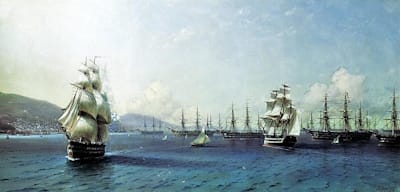
The bustling port, with its many languages, was a fertile environment to grow up in and its endless succession of ships and sailors would have been a constant reminder of the wider world. Family lore was that young Ivan began drawing with samovar charcoal on the white-washed walls. Whether with these drawings or in some other way, his talent attracted the attention of his father's friend, an architect. He gave the boy lessons in perspective and showed the resulting drawings to the town's governor, a cultured and well-connected man who would open doors for the talented young Armenian.
Education and Early Training
Young Ivan became friends with the town governor's son and was given watercolors and paper by the governor, whose promotion to provincial responsibilities saw him move his family to Simferopol, the capital of the province. Attending school there, Ivan's circle of friends expanded to include the son of Natalia Feodorovna Naryshkin, a woman with links to the Russian nobility who took a liking to Ivan and helped him secure a six-year scholarship to the Imperial Academy of Arts in St. Petersburg.
Sixteen-year-old Ivan's week-long journey to St. Petersburg, across the Ukrainian steppes to Moscow and on to the splendid city, which was experiencing its golden age, must have felt to Aivazovsky like a great breakthrough. He would make good use of the opportunity, even though he found the Academy's training rigidly formal and its social protocols unfamiliar. A report that he spent a lot of time in the Academy's sickbay with chest pains suggests that Aivazovsky was not entirely happy in St. Petersburg, but he worked hard and coped better with the pressure when he was put into the landscape class of Maxim Nikiforovich Vorobiov. His new teacher was a fiddle player like Aivazovsky (who had taught himself to play at the age of ten), and Vorobiov's interest in "atmosphere" in painting appealed to his young student.
When Emperor Nicholas I invited French seascape painter Philippe Tanneur to St. Petersburg in 1835, the Academy was asked to supply an assistant and Aivazovsky was given the job. The young man angered the French master by taking time off “sick” to complete a painting of his own, which won a silver medal at the Academy's exhibition that year. Tanneur demanded the painting's removal from the exhibition and Aivazovsky was seen by some as having committed an embarrassing social faux pas. But the Emperor asked to see Aivazovsky and, impressed by the meeting, bought the painting for the Winter Palace and sent the up-and-coming painter to sea with the Baltic Fleet as an opportunity to do more maritime painting.
Aivazovsky's rapid rise depended on the patronage his talent attracted, which was typical of the time. But he was also beginning to absorb Vorobiov's emphasis on atmosphere and adapt Tanneur's seascape technique in order to produce something distinctively his own. In 1836, he had seven paintings in the Academy's exhibition, winning a gold medal, and a reviewer predicted that "the artist's talent will take him far." When Pushkin visited the exhibition, Aivazovsky was introduced and the poet would appear as a contemplative figure in several of his seashore paintings in later years.
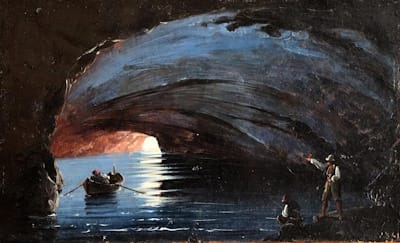
After another attachment as an observer with a naval unit engaged in skirmishes along the Black Sea coast, Aivazovsky's studies in Europe began with the support of the Academy, as part of his gold medal award and according to the Academy's practice of sending its promising students to European capitals. Aivazovsky spent time in Berlin, Vienna, and Rome, where he lived for two years, and his Italian travels also took him to Venice, Florence, and Naples, while other trips included Holland, England, and six months in Paris. His work was well-received, with the Italian publication The Art Gazette writing in 1840 that “the newspapers have sung his praises loudly and all are unanimous that only Aivazovsky is able to depict light, air and water so truly and convincingly. Pope Gregory XVI has purchased his picture Chaos and had it hung in the Vatican, where only the pictures of the world’s greatest artists are considered worthy of a place. His Chaos is generally held to be quite unlike anything seen before; it is said to be a miracle of artistry.” In 1842 Aivazovsky met the English painter J.M.W. Turner, who was living in Rome that year, and Turner greatly admired the technical precision in Aivazovsky's paintings. In addition to Turner, influences on Aivazovsky included works by the English painter William Martin and the French painter Théodore Géricault.
While a peripatetic Aivazovsky travelled, painted and absorbed a sense of what other artists were doing, the artistic and intellectual milieu of the early 1840s was still deeply affected by late Romanticism, but a schism was about to break out between Slavophiles and Westernizers, between those who sought distinctively Russian aesthetic solutions and those who wanted to be part of larger European currents in art. In Italy, Aivazovsky met and travelled with the writer Nikolai Gogol, a committed Slavophile whose provincial background had been similar to his own. Both men were coming to terms with Romanticism's impact on the European imagination but, while Gogol would undermine Romantic pretensions in his writing, Aivazovsky's Romanticism would become more full-blooded and expansive. While exposure to the art of Italy and Paris honed Aivazovsky's technical skill (he called his time in Italy a "second Academy"), it was the airiness of Dutch seascapes, Turner's atmospheric turmoil, and late-Romanticism's dwarfing of the human in the face of nature's power that Aivazovsky absorbed. This put him on the Westernizing side of the intellectual rift that was appearing in Russian culture, not least in his pursuit of a distinctively individual style rather than the expression of a particularly Russian sensibility. As such, we can think of Aivazovsky as very much a successful protégé of the "academy" tradition in Europe, with which the Russian Academy had aligned itself.
Mature Period
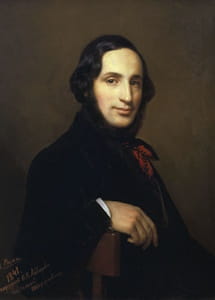
When he returned to Russia in his late twenties, Aivazovsky became an academician of the Imperial Academy of Arts. He was already more successful than contemporaries such as Alexey Tyranov, who painted his portrait in 1841. He was appointed the Russian Navy's chief painter, allowing him to produce more seascapes, coastal scenes and naval battles - his favorite themes. In 1845, after traveling to Constantinople, which he viewed romantically as the spiritual capital of his world, he settled in his hometown of Theodosia where he built an impressive house and studio and enjoyed some celebrity, holding a major exhibition of his work there in 1846. In 1847 he became a professor of seascape painting at the Academy.
In 1848, Aivazovsky married Julia Graves, an English governess with whom he would have four daughters. It was not a happy marriage and the settled life would not be without interruptions. With the outbreak of the Crimean War, Aivazovsky's usefulness as a painter of stirring naval scenes saw him once again following the fleet. At the war's end, he went to Paris and painted twenty-five pictures there, exhibiting them with considerable success and selling many. The French Emperor recognized his work and social standing by awarding him the Legion of Honor, a unique achievement for a foreign painter. Aivazovsky, the academician, had become a pillar of the Russian artistic establishment and part of the European cultural élite.
In the 1860s and 1870s, however, Russia saw seismic changes that rendered Aivazovsky something of an artistic dinosaur. With the succession of Alexander II, the "Tsar liberator" who relaxed the imperial grip on Russian society, the emancipation of serfs, and other social reforms, there were calls for "bringing arts to the people" and for artists to attend to the social realities of their own country. As a grandee of the old artistic order, Aivazovsky refused to change - his subjects remained the grandiose ones on which he had built his success - the stirringly romantic seas, the visionary imagining of Constantinople's splendor, the vastness of the steppes, the naval feats symbolizing man's valor in the face of elemental forces.
In 1867, the Empress and her children, returning from a visit to Constantinople, announced their intention to visit Aivazovsky in Theodosia, where he now had an estate outside the town. He met the imperial yacht in the harbor, accompanied by flower-covered gondolas. Overseen by Aivazovsky, the town was festooned with flags and a triumphal arch had been constructed, costumed children performed a special ballet, and a lavish meal was held at Aivazovsky's estate against a huge painted backdrop of a romanticized Constantinople. For the next thirty years, Russia would see profound social and cultural changes, but it is as if Aivazovsky's painting got stuck in time that day, when he entertained the Empress in the town where he had escaped his humble upbringing and presented her with a painting of their extravagant festivities.
Late Period and Death
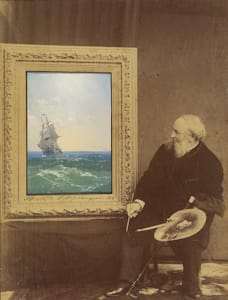
Aivazovsky would continue to paint prolifically and lucratively, until his last exhibition in St. Petersburg in 1900, not long before his death, and those last three decades saw his technique magisterially consolidated. His virtuoso skill was in repeating what he had become so successful at doing. When he transformed the fishermen of Theodosia into Venetian gondoliers for the Empress' delight, Aivazovsky staged a version of his own painterly vision, in which the ordinary disappears behind the art of the self-consciously sublime.
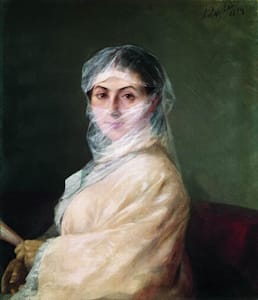
Aivazovsky spent his final years in Theodosia, where he played a role in the establishment of a commercial port that was linked to the railway network of the Russian Empire. When the railway station opened in 1892, it was named Ayvazovskaya, in the artist’s honor. He started an art school in Theodosia, continued to travel - his 1872 exhibition in Nice drew enormous crowds - and he opened the first provincial art gallery in Russia. He received further honors. He re-married more happily at the age of sixty-five, to twenty-five year old Armenian widow Anna Burnazian. In 1892, he travelled to North America, where he had twenty paintings in the World Exhibition in Chicago. His eightieth birthday saw Theodosia decked out in celebratory flags once again, its hotels full of visiting dignitaries. Not long after, he gave his last class at the Academy - an energetic two-hour practical demonstration of seascape technique that ended with rapturous applause.
When Aivazovsky met Russian playwright and author Anton Chekhov in 1888, the writer summed up the artist’s personality by stating “Aivazovsky […] is full of a sense of his own importance, has soft hands and shakes your hand like a general. He's not very bright, but he is a complex personality, worthy of a further study. In him alone there are combined a general, a bishop, an artist, an Armenian, an naive old peasant, and an Othello.” Aivazovsky passed away on May 2, 1900, and was buried in the courtyard of St. Sargis Armenian Church. His grave is marked with a marble sarcophagus by Italian sculptor L. Biogiolli, with an inscription that reads "He was born a mortal, left an immortal legacy.”
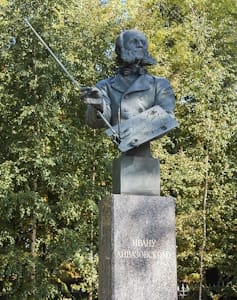
In 2003, a monument to Aivazovsky by sculptor Yu. Petrosyan was erected in Armenia’s capital city of Yerevan, and in 2007, a monument to Aivazovsky, designed by sculptor Vladimir Gorevoy and architect Nikolai Elgazin, was installed in Kronstadt, a port city and naval base on Kotlin Island, just west of St. Petersburg, where the artist often went to paint seascapes. In 2018, Russian citizens voted for the Simferopol International Airport to be renamed in honor of Aivazovsky, and his face also appears on the 20,000 Armenian dram note. In 2023, New York’s Metropolitan Museum of Art caused a stir when, in response to the Russian invasion of Ukraine, they reclassified Aivazovsky as a Ukrainian artist. Armenian historian Vartan Matiossian challenged this decision, calling it a “misplaced decolonization effort” and arguing that “the fact that [Aivazovsky] was baptized as Hovhannes Aivazian in the Armenian Apostolic Church St. Sargis of Feodosia and buried in the same church 83 years later, along with his strong identification with the Armenian people, should already tell us something about his identity. He did not belong to the Ukrainian Church and did not speak Ukrainian.”
On February 18, 2024, an Aivazovsky painting titled Moonlit Night (1878) was sold at Russia’s Moscow Auction House for about $1 million. What made the sale controversial was that the work was documented as having been stolen from the Mariupol Museum of Local Lore in Ukraine. Lydia Zaininger, the executive director of the Ukrainian Institute of America, asserted that “Putting it up for public auction is an affront to international rules of order, a flagrant violation of UNESCO’s laws protecting stolen art, and further clear evidence of Russia’s genocidal campaign to destroy Ukraine’s cultural heritage.” New York Times journalists Jeffrey Gettleman and Oleksandra Mykolyshyn wrote in 2023 that “International art experts say the plundering [of Ukrainian art by Russia] may be the single biggest collective art heist since the Nazis pillaged Europe in World War II.”
The Legacy of Ivan Aivazovsky
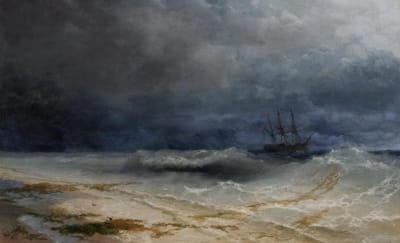
Though Aivazovsky remains little-known outside of Russia, there, he is celebrated as one of the greatest painters, and certainly the greatest seascape painter, the country has ever known. Indeed, in Russia, around the time of his death, the phrase "worthy of Aivazovsky's brush” (which first appeared in Anton Chekov’s 1897 play Uncle Vanya) became a common saying to describe something beautiful. Aivazovsky also holds the honor of being the first Russian artist to have his work displayed at the Louvre. Art historian Victoria Charles has written that “Aivazovsky’s achievements were well-deserved as no other artists managed to encompass the most difficult of subjects, the changing ambience of the sea, with such intensity and precision. […] In keeping with the great Russian landscape artists from the start of the 19th century, and without ever imitating anyone, Aivazovsky created his own school and his own traditions which distinctly mark the maritime genre as of his time and of future generations.” He is believed to have executed anywhere from 6,000 to 20,000 paintings over the course of his life.
Aivazovsky was Russian art's "last Romantic".. His travels to European capitals put him instinctively on the side of the Westernizers in Russia's cultural schism of the late nineteenth century, but his subsequent reaction to Slavophile calls for a more authentic art was to retreat into a conservative and dreamy vision of Constantinople as an imagined spiritual capital for a hybrid European and Eastern identity, of Crimean gypsy encampments as an idealization of community, of fishermen dwarfed by the sea and peasants dwarfed by the steppes, of Ukrainian farmsteads warmed by the almost divine benevolence of a nurturing sun. Aivazovsky was not a plein-air painter - he painted in his studio from drawings - and his scenes are never explorations of what he was looking at but rather imaginings assembled out of collected details and his own memory. Typically, he had not witnessed what he painted but instead gathered enough details in his sketchbooks to paint something that he had seen in his mind's eye. In that respect, Aivazovsky's legacy is considered by some as minimal, his Romanticism superficial, his working process and intentions self-indulgent to today's critical taste, his rapid turnover of canvases pandering to the demand for more of the same from his exhibitors and buyers, and his conservatism out of reach to the radical forces that would re-shape and re-energize Russian culture.
In another respect, however, Aivazovsky's legacy still resonates. His skies were always thinly painted, usually in one fast session using thin washes, but his seas were layered on with thick brushes, working outwards from a center of detail, such as a ship, so that the peripheral vision is more impressionistic than detailed. Unlike other nineteenth century academicians who painstakingly and methodically worked over a canvas in precise detail, Aivazovsky's engagement with the canvas could be much more instantaneous, embodied, and visceral at times. He would propel his body at the surface, brush in hand, in order to create the force he wanted in the paint. Visitors to his studio report the physical effort he exerted and the exhaustion that often resulted from working rapidly and with such physical intensity. While Aivazovsky's placid scenes often feel dated and lifeless now, many of his stormy seascapes still churn with this energy and physicality. This commitment of his own body to the act of painting, and the resulting viscerality of his seas as painted surfaces, still feels vividly alive and exemplary of what painting can achieve through its raw materiality.
Influences and Connections

-
![Claude Lorrain]() Claude Lorrain
Claude Lorrain -
![Théodore Géricault]() Théodore Géricault
Théodore Géricault - Salvator Rosa
- Paul Delaroche
- Philippe Tanneur
-
![Cai Guo-Qiang]() Cai Guo-Qiang
Cai Guo-Qiang - Arkhip Kuindzhi
- Lev Lagorio
- Mihhail Latri














